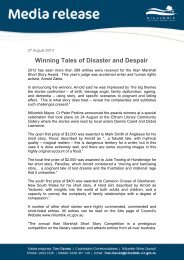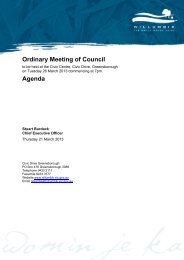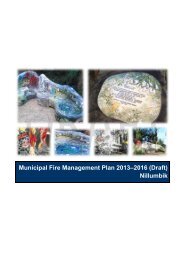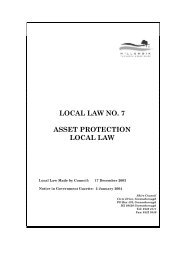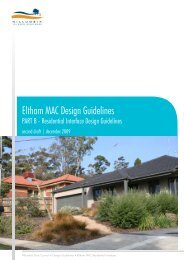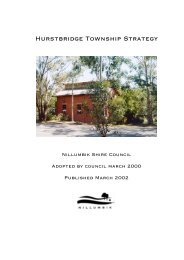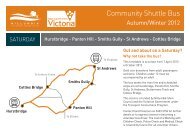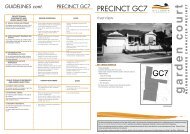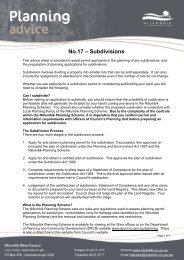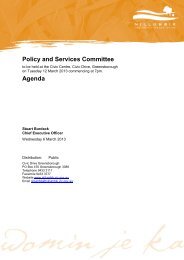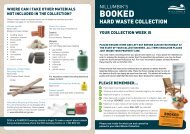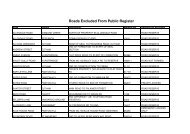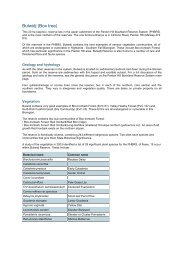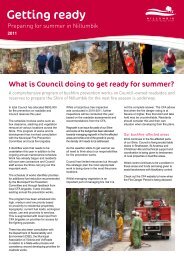Sustainable Water Management Plan - Nillumbik Shire Council
Sustainable Water Management Plan - Nillumbik Shire Council
Sustainable Water Management Plan - Nillumbik Shire Council
You also want an ePaper? Increase the reach of your titles
YUMPU automatically turns print PDFs into web optimized ePapers that Google loves.
Objective 6: Monitor and report on <strong>Council</strong> and the community’s water<br />
consumption annually.<br />
<strong>Council</strong> action Priority Responsibility Partners<br />
6.1 Establish a corporate water consumption database which ongoing EP<br />
details annual water bills and consumption, and allows for<br />
monitoring of works undertaken to reduce water use.<br />
6.2 Update <strong>Council</strong>’s water consumption data into the ICLEI ongoing EP<br />
database annually.<br />
6.3 Implement systems to record water saved through the ongoing EP<br />
actions implemented by <strong>Council</strong>.<br />
Theme 2: Stormwater quality<br />
<strong>Council</strong>-led community action Priority Responsibility Partners<br />
6a Report annually on community consumption levels to the ongoing EP<br />
community via internet and local media campaign and<br />
<strong>Council</strong> publications.<br />
Background<br />
<strong>Nillumbik</strong> <strong>Shire</strong> <strong>Council</strong> adopted its Stormwater<br />
<strong>Management</strong> <strong>Plan</strong> 2002 (SMP) and its Domestic<br />
Wastewater <strong>Management</strong> <strong>Plan</strong> 2006-2009<br />
(DWMP) to address the health and environmental<br />
issues faced due to reduced water quality in local<br />
waterways throughout the <strong>Shire</strong>. The <strong>Nillumbik</strong><br />
Environment Strategy (2001) also provides direction<br />
for <strong>Council</strong> in developing programs that help to<br />
improve water quality.<br />
This <strong>Plan</strong> does not attempt to override nor repeat<br />
the above plans but instead aims to complement<br />
and address the issues raised in each of these<br />
plans since their development. There are significant<br />
differences in the aims and focus of the related<br />
<strong>Management</strong> <strong>Plan</strong>s, with the DWMP focusing on<br />
minimising the impact of domestic wastewater<br />
on human health and the local environment and<br />
the SMP providing a framework for integrating<br />
stormwater management as part of <strong>Council</strong>’s<br />
existing management and planning activities. The<br />
<strong>Sustainable</strong> <strong>Water</strong> <strong>Management</strong> <strong>Plan</strong> seeks to raise<br />
the profile of water quality in <strong>Council</strong> operations and<br />
throughout the community.<br />
Stormwater is the water that runs off roads, car<br />
parks, roofs of buildings and other hard surfaces<br />
when it rains, and discharges into the nearest<br />
waterway. Stormwater runoff enters waterways via a<br />
network of sub-surface pipes or as overland runoff.<br />
In urban areas, the rain runs off hard surfaces into<br />
gutters or pipes that channel the water into drains,<br />
which lead directly to the closest waterway. In<br />
<strong>Nillumbik</strong>, stormwater runoff is directed to Diamond<br />
Creek, Arthurs Creek, the Plenty River and the Yarra<br />
River. These waterways eventually discharge into<br />
Port Phillip Bay.<br />
The urban and rural drainage network was<br />
developed to minimise the threat of flooding and<br />
traditionally does not take the environmental impact<br />
of stormwater into consideration. All activities and<br />
practices that occur within a waterway’s catchment<br />
impact on stormwater quality and therefore river<br />
health. Stormwater accumulates pollutants as it<br />
flows over hard surfaces. Pollutants that often occur<br />
in urban areas include leaves, grass clippings,<br />
dog droppings, car washing detergents, fertilisers,<br />
sediments, litter, oil, grease, chemicals and a myriad<br />
of other toxicants.<br />
Run-off from rural areas is another source of<br />
contaminants. This often includes nutrients from<br />
fertilisers and septic systems, toxicants from<br />
pesticides and herbicides, sediment, and faecal<br />
matter from livestock. Over-grazing, livestock access<br />
to rivers and creeks, poor irrigation and nutrient<br />
management practices, and runoff from unsealed<br />
roads also add to the pollution of rivers and creeks.<br />
Unlike sewage, stormwater is not normally treated<br />
before it enters the waterway, and hence has been<br />
identified as a major contributor to the degradation of<br />
many aquatic environments.<br />
28 <strong>Sustainable</strong> <strong>Water</strong> <strong>Management</strong> <strong>Plan</strong> <strong>Sustainable</strong> <strong>Water</strong> <strong>Management</strong> <strong>Plan</strong>



